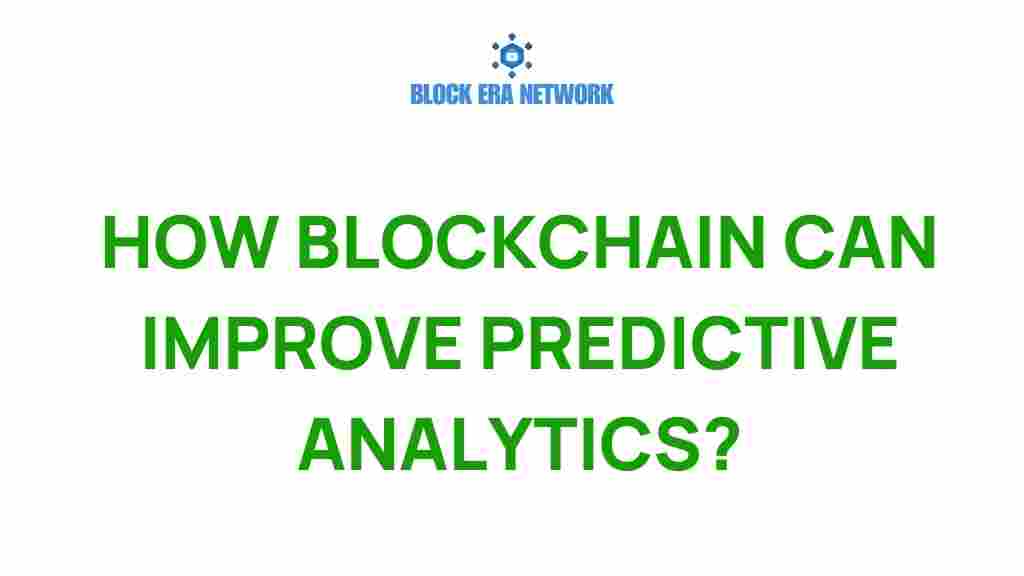Unlocking the Future: How Blockchain Can Transform Predictive Analytics
In today’s rapidly evolving technological landscape, the integration of blockchain and predictive analytics is set to revolutionize how organizations leverage data. As businesses strive for better decision-making, the need for data integrity, data security, and transparency has never been more critical. This article explores how the synergy between these technologies can enhance machine learning, improve real-time data accessibility, and foster decentralized systems. Let’s dive into the transformative potential of blockchain in predictive analytics.
The Intersection of Blockchain and Predictive Analytics
Predictive analytics involves using statistical algorithms and machine learning techniques to identify the likelihood of future outcomes based on historical data. When combined with blockchain technology, which provides a secure and transparent way to record transactions, organizations can enhance the reliability and accuracy of their predictive models. Here’s how:
- Enhanced Data Integrity: Blockchain’s immutable ledger ensures that data used in predictive analytics is accurate and tamper-proof.
- Improved Transparency: Stakeholders can verify data sources and analytics processes, promoting trust in the results.
- Decentralized Systems: Blockchain enables data sharing across various entities without the need for a central authority, fostering collaboration.
Understanding the Benefits of Blockchain in Predictive Analytics
The application of blockchain in predictive analytics offers several significant benefits:
- Data Security: With blockchain’s encryption and decentralized nature, sensitive data is protected against unauthorized access and breaches.
- Real-Time Data Access: Blockchain allows for real-time data updates, ensuring that predictive models are based on the most current information.
- Collaboration Across Industries: Different organizations can collaborate without compromising data privacy, sharing valuable insights while maintaining control over their data.
Step-by-Step Process: Integrating Blockchain with Predictive Analytics
To effectively integrate blockchain with predictive analytics, organizations can follow these steps:
Step 1: Identify Data Sources
Begin by identifying the data sources that will feed into your predictive analytics models. This may include:
- Internal databases
- Third-party data providers
- IoT devices
Step 2: Implement Blockchain Technology
Choose a suitable blockchain platform that aligns with your organization’s needs. Consider factors such as:
- Scalability
- Interoperability with existing systems
- Ease of integration with machine learning tools
Step 3: Establish Data Governance
Define data governance policies to ensure compliance and data integrity. This includes:
- Access controls
- Data sharing agreements
- Audit trails for data usage
Step 4: Develop Predictive Models
Utilize machine learning algorithms to develop predictive models using the data stored on the blockchain. Ensure that:
- The models are trained on high-quality, verified data.
- Continuous learning is enabled by integrating new data as it becomes available.
Step 5: Monitor and Optimize
Regularly monitor the performance of your predictive analytics models and the blockchain system. Use feedback to:
- Refine algorithms
- Improve data collection methods
- Enhance security measures
Troubleshooting Tips for Integrating Blockchain and Predictive Analytics
While the integration of blockchain and predictive analytics can be incredibly beneficial, challenges may arise. Here are some troubleshooting tips:
1. Data Quality Issues
If the data quality is inadequate, it can lead to inaccurate predictions. To resolve this:
- Regularly audit data sources.
- Implement cleansing processes to remove or correct erroneous data.
2. Scalability Concerns
As data volume grows, scalability can become an issue. To address this:
- Choose a blockchain solution that can handle increased loads.
- Consider layer-2 solutions to improve transaction speeds.
3. User Adoption
Resistance to new technology can hinder the adoption of blockchain systems. To encourage user acceptance:
- Provide training and resources.
- Highlight the benefits of improved data security and transparency.
4. Compliance and Regulatory Challenges
Ensure compliance with data protection regulations such as GDPR. This can be managed by:
- Implementing data anonymization techniques.
- Staying informed about regulatory changes in the blockchain space.
Conclusion
In conclusion, the fusion of blockchain and predictive analytics holds immense potential to transform how organizations approach data. With enhanced data integrity, improved data security, and increased transparency, businesses can make more informed decisions and drive better outcomes. By following a structured approach to integration and addressing potential challenges, organizations can unlock the full benefits of this powerful combination.
For more insights on data security and analytics, visit this resource. Additionally, to explore blockchain technologies further, check out this website.
This article is in the category Blockchain Basics and created by Block Era Network Team
